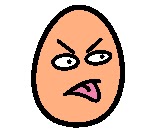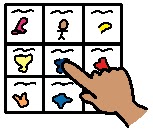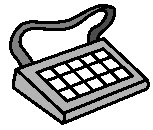
Choosing vocabulary for someone who uses Augmentative Communication can be challenging! There are many factors to consider including receptive understanding of symbols/words, number of symbols on a page, categorization etc. It's also important to remember that kids may want to use cool phrases or terms when speaking with other kids.
- Create a list of your child's likes and dislikes. Often children want to communicate about things that are exciting and fun for them. Motivation is key!
- If you aren't sure your child is picking something on purpose, try including a non-preferred item in the choices given, such as kleenex, a hair brush etc.
- Make a list of things that kids the same age are saying and doing. If you are recording onto a device, have a fellow classmate of the same gender record his or her voice.
- Ask classmates and peers their opinions about the things your child might want to talk about and what words or phrasing to use.
- Model using symbols so that your child's understanding of symbols grows. Point to symbols in a low tech display or available in their environment.
- Document the things you child does and what it means to you. For example - looking at the fridge means "I want something to eat or drink", looking up and to the right means "yes". Share this information with all the people who communicate with your child. This is sometimes referred to as a communication dictionary.
Keep in mind that individuals interacting with a child who uses AAC may have differing ideas and approaches when it comes to selecting vocabulary and the purpose that the vocabulary will serve. Here are some thoughts from Robin Hurd, parent of two children who use AAC:
"Parents tend to want their child to learn words that can help them talk about what hurts, what they want to do or their feelings and emotions. School teachers tend to want to focus use of the AAC system on “showing that you know stuff” like color and number identification, and a speech pathologist may want to focus on ideas like taking turns during a conversation. Each of these ways of using an AAC system is different and tends to lead to an AAC system (the device and the interventions) being structured in a different way. An SLP whose concern is taking conversational turns, for example, might set up an AAC system where the child has access to several related sentences: “Hi how are you? I’m fine. It’s nice to talk with you”. A teacher may want to set up activities on an AAC system that allow the child to access the words she feels are important to demonstrate knowledge, but may not wish to teach basic words needed for communication. A parents’ ideal AAC system will include words that a child can use to explain feelings, likes and dislikes and talk about what is important to the child. Parents report conversations with their children who use AAC such as calling siblings names, pretending about an imaginary pet and calling story characters in the telephone."
To clarify the process, and to ensure that everyone's opinions are heard, have the team come together to talk about vocabulary selection. Whenever possible and appropriate to do so, include your child in decisions about adding or removing vocabulary items from a display.
Next steps...
- Remember that simply providing the words is not enough. We need to teach our students what the words mean and how to use them.
- Once your child is using some highly motivating vocabulary, try expanding the vocabulary to include comments such as "I like it, I don't like it". Model how to use these comments by pointing to them and saying them aloud yourself. This shows kids how to use the symbols.
- Use the same vocabulary across a variety of activities. This helps kids to understand that these symbols can be used to say the same thing in different ways.
- Continue to model using symbols with core vocabulary - vocabulary most often used in speech. Check out our past issue for more information on core vocabulary - I Can...find the words! (February 2009)
- Once your child's vocabulary starts to grow, it will need to be organized so that he/she can find words quickly and easily. You can introduce the concept of categorization while playing with your child. For example, when playing with a doll, have your child find all the clothes to dress the doll. Then find all the food to feed the doll. Check out some of these ready-made resources for sorting and categorization: http://www.speakingofspeech.com/Language_Materials.html#Categories If you need additional assistance organizing vocabulary, talk with your TVCC ACS Speech Language Pathologist.
- Have a voice at your TVCC appointments! Remember to bring your communication board to all your appointments. Sometimes the visual reminder of seeing your board will prompt your clinician and others to talk to you. Forgotten to bring your board? Ask your clinician to find a board for you. There are some generic communication boards available at TVCC reception, fitness centre, clinic, Seating and Mobility Services (SAMS).
- London Public libraries have communication boards available for your child to use. Look for the special symbol at the desk to request a communication display
Light Tech Solutions
- Record novel messages on your child's simple speech generating device to keep your child and his/her communication partners engaged. Sharing a surprise message, some news from home or being able to ask a question can be highly motivating. Involve your child when deciding on the messages to record. Include messages that reflect your child's interests - talking about his / her favourite sports team, favourite person, new addition to the toy car collection. End the recorded message with a question to encourage some back and forth interaction between the message giver and listener.
- Many high tech Speech Generating Devices come with pre-loaded vocabulary. Be sure to look through pages that may be of interest to your child. You can edit pre-made pages to more effectively meet your child's needs (e.g. decrease number of symbols etc). You can also check the manufacturer's website online for additional pages to download.
The power of peers has an awesome impact! Dylan took it upon himself to get to know Josiah better, and how he uses his iPod to communicate. In this video, Dylan provides verbal and physical prompts to help Josiah to use his speech generating device. Support was also provided by the school and ACS staff to make the peer-to-peer communication interactions more successful. The rapport and friendship that these two have developed is really inspiring. Check out this clip to see the benefits of having peer support to prompt an AC user to use his/her device successfully! If you are an ACS client, ask your clinician if you want to know more about prompting through peers.
Resources:
Information on vocabulary selection:
AAC at the University of Washington:
http://depts.washington.edu/augcomm/01_vocab/vocab1_intro.htm
Robin Hurd's article about vocabulary organization on an AAC system from the parents' perspective:
http://www.aacinstitute.org/Resources/ParentsCorner/2008August-September.html







No comments:
Post a Comment